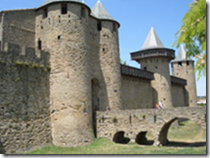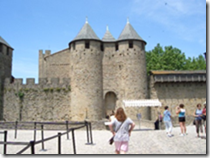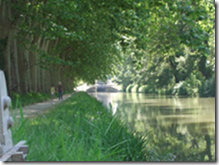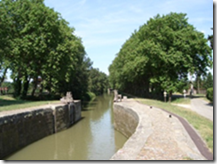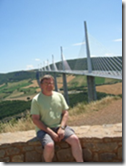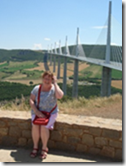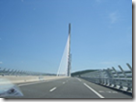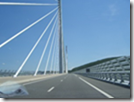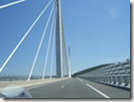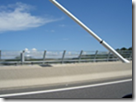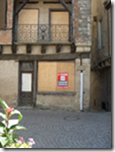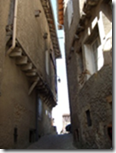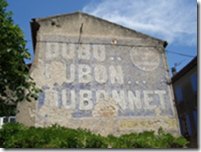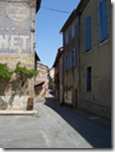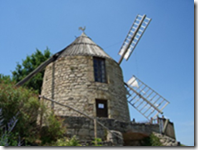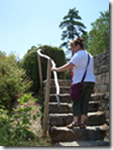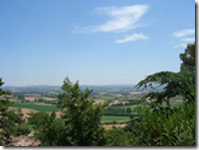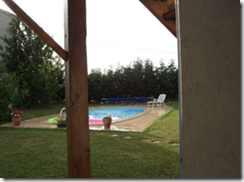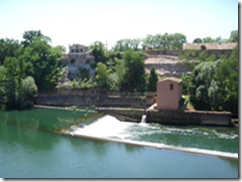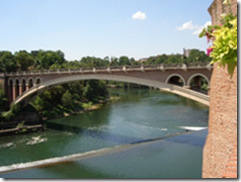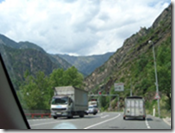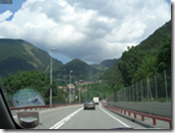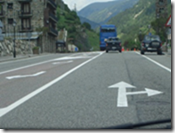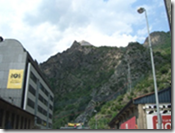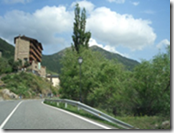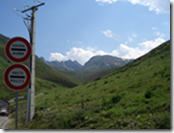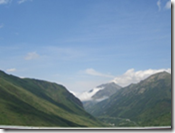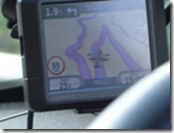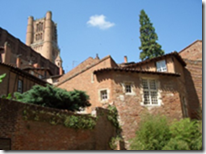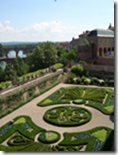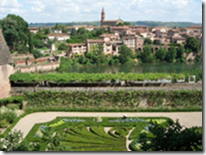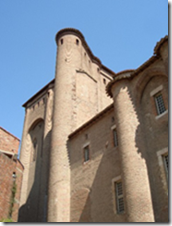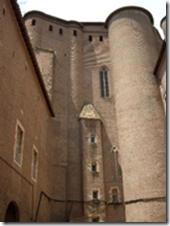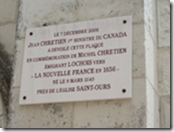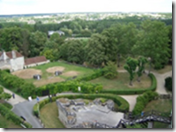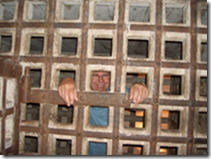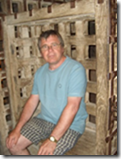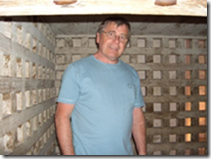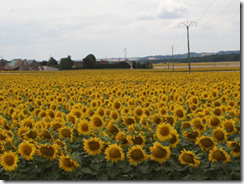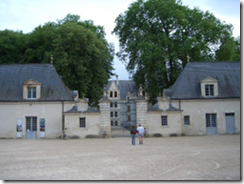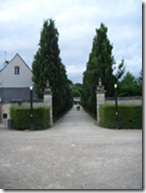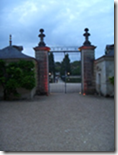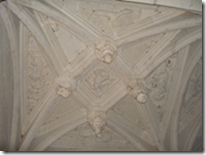Part One: Midi-Pyrenees & Longuedoc-Roussillon.
Friday 26th June
7.45pm, Portsmouth Ferry Port. The overnight ferry to St Malo. We’d only been here a week earlier, when we had popped over for a 24 hour shopping trip from St Malo to Cherbourg. It had given Cathy a chance to get some practice in driving in France.
The ferry is OK. There is nothing exciting about the ferry journey really; it is just a means to an end. The cabin is a little box with no windows, but it does have bunk beds and a shower/toilet cubicle. We hadn’t eaten, as when we had got home from work we had loaded up the car and gone pretty well straight there.
At the restaurant/cafeteria we grabbed something fairly light, and went to sit down. We both chose a salad, with ham and goats’ cheese. Stewart got to the table and realised that he hadn’t picked up any sugar for his coffee, so went back to the counter and grabbed a couple of sachets from the big plastic bucket. Or rather, it turned out he had only picked up just the one sachet. The other one turned out to be a rolled-up €50 note. Theft by finding? Tricky. We were in international waters, did that make it piracy? The note was not sitting at the top of the bucket, so could have been there for a while. No, whoever lost it is probably long gone. A nice start to our holiday, a sad end, or beginning, to someone else’s!
Some things just aren’t what they seem. A sachet of sugar turned out to be a €50 note, and lo and behold the rounds of goat’s cheese on our ham salads turned out to be poached eggs. Sneaky. It was not a problem, as we both like poached eggs, but it alerted us early on to being just that little bit more observant and careful about the food we chose.
Saturday 27th June
Woken for breakfast by a now-familiar irritating muzak from the ship’s piped radio, we watched the perfectly calm – flatter than a mill-pond – sea slide by, changed our watches to French time, then rolled off the ferry at just before 8.30am into the quiet streets of St Malo. We faced a long old haul to the south of France, and according to Sally Satnav could expect nearly 9 hours of constant driving at 70mph to get to the gîte by 5.22pm (yes, right, 5.22pm exactly? I don’t think so) – if we didn’t stop at all.
So Sally got us on the road. The route was initially southwest towards Bordeaux, via Rennes, Nantes and Niort. To be fair the roads were really good, and fairly empty. The biggest worry was about whether or not we would be able to get fuel, as a previous trip had led us to petrol stations that only took bankcards on a pay-at-the-pump basis, but didn’t take British cards. However, just like the motorway services in the UK, at vastly inflated fuel prices the French too are willing to take the traveller’s cash at every other Aire along the way. They also take your cash at motorway tolls (péage), and they ain’t that cheap. The first one was about €23 for 290 miles. Still, the €50 bonus from the previous evening paid for that (and more) and slowly, steadily and surely we headed through France to Toulouse, where we came off the motorways and got onto “normal” roads as we made our way towards Castres.
The gîte, at a small village called Guitalens-Lalbarède (the name is longer than the village!) was easy to find, and we rolled up there at just on 7.30pm. The couple that ran it (Susie and Robin) were welcoming and surprised that we had made it from St Malo so quickly. The gîte was nice and clean and wholesome, as well as offering a swimming pool and a complimentary bottle of wine. After the drive we had just had, both were very welcome. We had brought plenty of food with us, but somehow we weren’t really hungry. The bottle of wine didn’t last long though!
Sunday 28th June
We got up and out at 9.15 to go to the village to get some local produce. The temperature (which became an obsession as the week progressed) was already 18°c, and by the time we got back at 10.00 it had gone up to 21.5°c. The local produce included real boulangerie bread, still warm, and some local vegetables and cheese. Robin and Susie had advised us against buying any wine above €2 a bottle, as the cheap stuff was perfectly good. To be honest we don’t have sophisticated palates, so it was probably the best advice we’ve had from anyone for a long time. We took their advice, but did splash out on one bottle at the end of the holiday, and paid €2.08 for it.
Anyway, today was Carcassonne day and we set off for the walled city at 10.23 in a sweltering 25°c. Sally took us the “shortest” route, and that meant not the “quickest” route. She took us over the Black Mountains (26°c). Guitalens-Lalbarède was already at 170m above sea level, on a broad plain, and we had to climb high into these quite tall mountains that were savaged by sheer tree-clad ravines. That meant tortuous z-bend switchback roads that we negotiated at low speed both up and down. Half way over, we came across a memorial (with associated ossuary) to the local Resistance, which was very poignant.
Eventually, at about 11.50, we got to Carcassonne, with its fairy tale castle high on the hill, and settled into a detailed exploration of it. It is a walled city, so once you enter the fortifications, you are into what is effectively a huge shopping mall, with narrow twisted streets lined by narrow twisted buildings and all sorts of articles from really cheap tourist tat to really expensive artistic/designer tat, and not a lot in between. It has probably always been like that. In fact, most places are like that. We did at least find a nice bar to have lunch, a simple salad and carafe of wine (with another carafe of water) that the French are so good at.
After we had “done” Carcassonne, we stopped for a gentle shady walk along part of the Canal du Midi, the amazing waterway that links Bordeaux and the Atlantic with Marseilles and the Mediterranean.
By now the temperature was up around the 35°c region, and we were feeling a touch warm. When we got back to the gîte at 6.00pm, it was reading 32.5°c. The drive home was less tortuous, as we went by a more main-road route via Mazamet.
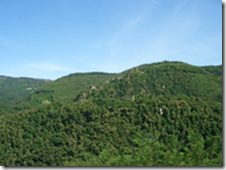 The Black Mountains from the road
The Black Mountains from the road 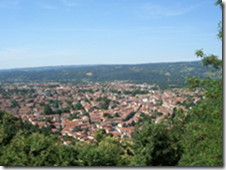 Mazamet from the Black Mountains
Mazamet from the Black Mountains
Monday 29th June
Today is Viaduc de Millau day. We saw the bridge on Top Gear a few years ago and were so impressed we wanted to go and see it. Cathy got really obsessive about the temperature today; yesterday’s high of 35.5°c had her watching the thermometer in the car almost as much as the scenery.
10.53am – 24°c; 11.20am – 25°c; 11.42am – 26°c; 12.34pm – 29.5°c; 12.40pm – 30.5°c; 1.12pm – 32°c; 1.19pm – 31°c (a drop!); 1.24pm – 31.5°c; 1.28pm – 32.5°c.
By now we were high in the Parc Regional des Grands Causses, deeply wooded high hills carved in two by the River Tarn, the obstacle that the Viaduc had been built to overcome. Round a corner we came, and there it was high in the sky above us, our first glimpse of this wonderful construction. We found a lay-by and pulled over to get a good look and take a few snaps. From there we went to the visitor centre that was built underneath it. There we saw the video of the construction, and found it amazing that it was completed in almost exactly 3 years and under-budget. In the UK we would today still be arguing over the planning permission vis-à-vis the alleged colony of lesser-spotted blodgebug that had been recorded within 10 miles of the site in 1726.
We then drove through the town of Millau itself, and followed the road signs to the Autoroute, the A75, and then the signs for Montpellier and Béziers, the southbound side of the road. Accessing the road, and taking our péage ticket, we then proceeded towards the bridge. As it came in sight, we spotted the Aire du Viaduc de Millau, and pulled in to see the bridge from there.
It was a warm day, and Cathy’s last reading of 32.5°c was almost certainly exceeded by the time we got to see the view. After climbing up to the viewpoint, we were hot and thirsty and a bit hungry, so we went back to the Aire and got a light meal there, and a drink. We had to sit outside under the shade of an umbrella, as all the flies were sensibly thronging inside the cool restaurant space to get out of the heat.
Then we set out to cross the bridge. What a show. Recommended.
From there, the road led us on south. We drove on through the hills, the road sweeping along through occasional vineyards and some sparse scrub – was this maquis country? Cathy’s temperature guide began again. Along the roadside were markers telling us how high above sea level we were. At 3.54pm, we were at 754mtrs, and the temperature was 31.5°c. As we slowly wound down the edge of the mountains near Clermont L’Herault and Lac du Salagu at 4.13pm, it reached 35.5°c. By the time we were on lower ground heading towards Béziers with the hot breeze from the Mediterranean blowing through the car’s open windows, at 4.27pm it hit 38.5°c. We finally got back to the gîte at 7.35pm (28.5°c, brrrr!), and had a swim before a light meal and a glass or two of wine.
Tuesday 30th June
Today we went shopping in the village again, collecting bread and vegetables at about 10.00am. After the past two days’ driving we had decided to have a bit of a more local day, and we set off for the little village of Lautrec just before noon (29°c). It was only a few miles away, and after passing through some very aromatic garlic fields we parked up in the shade of a tree.
Lautrec is part of the ancient heritage of the family of Henri de Toulouse-Lautrec, the well-known artist (more of him later). The village is in two parts like a hymnbook –the ancient and the modern. The ancient is both picturesque and sad, as there were several buildings there in dire need of repair and renovation. Empty window frames, or missing wall beams allowed birds and weather into them. The French are big on their patrimoine –heritage – so hopefully they will encourage maintenance of these properties.
The narrow streets and old buildings of Lautrec
The village is dominated by a hill with a windmill and at the very top a large stone cross. Cathy found a handrail that was the very definition of “rustic” going up to the windmill, and we felt that the concept of health and safety was mercifully on the side of common sense in France as a whole. There was a feeling that they were saying to us “look, it is a rickety old rail, so bloody well pay attention and take some responsibility for yourself and your safety”. It is the same with the paving in the streets. By the time we got to the top of the hill we were once again sweltering, but there was a hint of a breeze to take the edge off the heat, and after viewing the panorama, we went slowly back to the car.
Lautrec – the windmill, the handrail, and the view.
By now we had worked out that we were doing this all wrong. The French shut for lunch. Everything shuts for lunch. A long lunch. Often even the places you would go for lunch shut for lunch. We were hot and bothered: archetypal British tourists: mad dogs and Englishmen. We did find a bar in the “new” village just off the 5-way (nightmare) roundabout, and managed to get a cold, cold beer down us.
Back to the gîte by 2.15, where the summer was running at an impressive 33.5°c. We decided to enjoy the swimming pool, and relaxed in the sun for the afternoon. At 5.00pm we started up the car, just to see what the thermometer read. Stationary, and parked in direct sunlight it hit a smacking 43°c! Cathy managed to get stung twice on her arm by a wasp; she must have squeezed it between herself and the lilo. It looked like she had stapled herself.
The heat couldn’t last without having some effect on the rest of the weather, and sure enough clouds started to roll in off the Black Mountains. Then glory be we heard the first rumbles of a thunderstorm. And it rained. It was lovely.
Wednesday 1st July
After the rain the previous evening, it was a bit cooler today, no higher than 31.5°c this morning. What a let-down. Anyway we went off to Castres to get some shopping and petrol, and then got home to the gîte for lunch – ha-ha, we’ve worked out this lunchtime thing now! So by early afternoon we were on the road again, and we went to Gaillac, where we picked up some leaflets and looked at the regional wine display (without buying any – it was all well over €2 per bottle!), before heading on to the small town of Cordes sur Ciel – the “city in the sky”. Like so many of the villages and towns we had seen it was built on a hill, a rocky outcrop. Not big enough to build a “proper” castle on (and don’t forget Carcassonne and this area had loads of serious castles built during the Cathar unrest), but defensible enough. To be honest we were a bit over-filled with “old walled hill-top villages” by now, and although it looked like a really interesting place, we returned to the shopping area in the main square.
We bought some wasp (guêpes) sting repair and allegedly locally efficacious insect repellent from the pharmacist, then settled down to a coffee at a bar, before buying stamps for our postcards and setting off back home (38°c, that’s more like it). As we left we tried to identify the strange smell that pervaded the town – we got it in the end, it smelled of freshly struck Swan Vestas matches.
By not using Sally we managed to get lost, and we got back to Guitalens-Lalbarède by a different route, so we came in on a road that meant we were able to stop at the local bar for a couple of beers. We sat outside under a tree and watched four young lads playing pétanque, until one of them kindly offered to give Stewart a game. He said that the first one to score 13 wins. Stewart picked up the first point, and should have quit then. In the end 13-3 was a fair reflection of Stewart’s incompetence and the lad’s casual skill. Of course, suffering the burden of playing in 34.5°c meant that Stewart wasn’t at his most competitive.
Thursday 2nd July
Today we are determined to go to Andorra. Because we can. And because it was overcast and a bit dreary, it made for a bit of a drive. After yesterday’s misdirection without Sally, Stewart had drawn up a list of waypoints to take a route that Sally probably wouldn’t have chosen. We headed for Vielmur sur Agout, then Soual, Revel, Villefranche de Lauragais, and then the A66 motorway to Foix and beyond.
As we rolled along the motorway, the rain began to fall, spotting the dusty windscreen at first, then according to Cathy’s notes “chucking down”. Ahead the once-imposing bulk of the Pyrenees was disappearing into the murk. By 12.40 it was 15°c and we had warm air demisters keeping the windscreen clear. As the road narrowed and we climbed deeper into the foothills, the visibility began to reduce, until the road began to climb more steeply and the clouds began to surround us.
We confidently expected to drive on upwards and through the clouds, emerging amid the mountains in glorious sunshine with impressive views. Well, we didn’t. Ahead of us was a BMW, first he had his lights on, then he had his fog lights on; so did we. Then we couldn’t see the car in front of the BMW. Then we couldn’t see the BMW (down to a chilly 13°c). Or even its fog lights. Then we saw it, about 15 yards ahead of us (colder still at 11°c). We were doing less than 20 mph all the way up these mountains. Sally was showing us roads ahead, behind, and (worryingly) around us; all of these were just the one road. We negotiated hairpin bends and steep climbs, without a clue as to what views we were missing.
We came to the Andorran border and suddenly saw the car in front of the BMW again. The bored customs officers waved us through, disappointingly not stamping our passports. Well, actually, not even looking at our passports. A while later we came to a roundabout; we knew this because Sally told us so. To our right was the tunnel to Andorra, with a toll, ahead was the road over the pass without a toll. We took the road. Mistake.
It went on and on still in dense white fog. And on. We passed petrol stations carved into the mountainsides, but couldn’t see them until we were almost past them. Eventually we started to go downhill. Then there were wisps of thinner fog, then we started to see the ground on either side of the road, then we reached another roundabout – the other end of the tunnel, and suddenly we could see.
This should have been our Shangri La or Brigadoon moment; the beautiful hidden valley bathed in sunlight. But it wasn’t. It was still grey and just deep and steep. The road led on down into the main body of the Principality through scary vertigo-inducing hairpin bends, and then we met the first hotels. Basically Andorra is two things. Firstly, it is a tax haven, and secondly it is a winter ski resort. We hadn’t enough money to enjoy a tax haven, and not only was it not winter but we don’t ski anyway.
Andorran roads – clinging to valley sides
The buildings are designed to be seen in the snow, all frosted and Christmas card-like. In the height of summer, they were concrete and harsh stone, with dark brown wood cladding to make them look like obese and elongated pseudo-chalets. As long-time residents of Portsmouth they reminded us of a cross between the Tricorn and Portsdown Park with a bit of cladding by way of camouflage. Bear in mind the Tricorn was one of Britain’s ugliest buildings (official), and Portsdown Park was so bad it was knocked down long before the Tricorn was.
Andorran architecture: looks better in the photos than in real-life!
As we got to the heart of the capital, Andorra-La-Vella, Sally burst into life, with the traffic delays alert showing red for the first time ever. We don’t subscribe to any traffic alerts outside the UK, but occasionally in France Sally would get them near major cities, and here in Andorra it was giving us warning of delays 0.2 miles ahead. We could see the cause of the delay. The traffic lights were red. Then they turned green. Sally’s traffic alert turned green. That was as exciting as it got in Andorra!
We stopped at a café just before 2.00pm, and had a cuppa and a square pizza. The waiter spoke Spanish, like they do in Andorra. We didn’t, and our faltering French didn’t impress him. In excellent English he asked, “What language are you trying to speak?” Bastard.
After our meal we went and did some duty free shopping. At least some of it was duty free; we couldn’t work it out. Some of the whiskies were the same price as in the UK; some were a third of the UK price. Absinthe was just over €4 for a litre of 65% proof. It was crazy (well, you would be…). On the way out we filled up with petrol at €0.97 per litre (the cheapest in France was €1.20).
Although the sun was now shining and all the clouds had gone, we chose not to go back over the mountains, instead taking the tunnel. It probably saved us at least half an hour, maybe more, and also probably saved us the terror of seeing the cliffs we had blindly driven along earlier. Not long after this, and we were back at the border, where the customs were stopping and searching roughly one car in four. We tried our best to look suspicious, at least that way we might get our passports stamped, but no, they waved us through again.
Back in France, we were on our way retracing the route to Foix and onward. That area is known for it’s ancient caves with prehistoric wall paintings, but it was too late for us to go and visit any by now. Along the valley there were caves in the cliffs, and signposts suggesting they would be great places to visit. Maybe next time. We got home at about 7.00pm, perhaps a bit later, and after a shower and meal, Susie and Robin invited us to sit and chat over a bottle or two of wine and some finger snacks. We got the impression that they were very new to the gîte business; they seemed to act on our every suggestion, realising that there was something they had forgotten to provide. We genuinely thought we might have been their first guests.
Friday 3rd July
Earlier on we promised you more about Henri de Toulouse-Lautrec. Well, here it comes. He was born in Albi, not far north of where were staying. They have a museum there to celebrate this fact. Albi also has a strange cathedral, which is a massive edifice built of brick.
At 10.21, and 22°c, Sally set off for the Musée de Toulouse-Lautrec in Albi. An uneventful drive past the garlic fields again (10.33, 25°c) led us to one of the busiest places we had visited all week, having successfully avoided city centres wherever possible. More by luck than Sally’s judgement we managed to find a convenient parking space underneath a market right next to the Cathedral. We walked through the market promising ourselves we would come back in a while and do some shopping.
The museum was actually in the old bishop’s palace attached to the Cathedral, and after walking around and admiring the buildings and the gardens, we went in to take a look. Like most museums we weren’t allowed to take photographs inside, so we simply admired his work, and learned a lot about his life history. Apparently he suffered injuries as a child when he broke his legs, and his stunted growth was partly down to that. He was also not generally healthy anyway by the sounds of things, but undoubtedly his somewhat Bohemian lifestyle in the bars and cafés of Paris did little to help. He returned to the area to live his last years with his mother. Considering he did not really have a long career, he completed a lot of work, and mastered a lot of different techniques. Some of his drawings, incredibly detailed, yet almost caricatures, were fascinating, especially compared to the huge flat colours of the posters he is most famous for.
The Bishop’s Palace and gardens by the river
We left Henri and went to the Cathedral, which was impressive mainly for its size and obvious weight of the bricks that make it up; you had no option but to begin to try to imagine how many bricks it had taken to build it. Most cathedrals are made of huge blocks of stone; stone blocks are not just big, they impart a sense of permanence and durability. Brick seems somehow fragile and temporary in comparison. But this isn’t. It is simply huge, with buttresses that look like they were modelled on a body-builder on steroids.
“So, why exactly don’t you want to be a hod carrier?”
When we went back to the car we found that the market was closed for the day, all the fresh produce long gone. We may have worked out lunch, but shopping was still a bit rusty. So we set off back to the gîte again, in un-noted warmth of the sunny day. We were driving along the road through the avenues of plane trees (“child killers”, the locals call them, as they account for an increasing number of young drunken drivers killed every year; they think it would be better to cut down the trees than cut down the drinking) with the windows down, at a leisurely pace.
Then there was a driver frantically flashing his headlights at us.
All across France they grow vast fields of maize, sunflowers, or grains, and they water them copiously. They have huge hosepipes that blast jets of water in huge arcs across the fields, nudged into motion to cover a great circle over a period of time. These hoses are attached to massive reels that enable them to be moved at will across the large flat fields to water every part.
So there we are driving along with the windows down when this driver flashed by on the other side. Suddenly we saw the problem. The hose had become disconnected from the reel at the edge of the field on our left. A perfectly horizontal fountain of high-pressure water was blasting across the road and into the field on the right. The brakes were hit as the buttons were frantically pressed to get the electric windows up. The spout of water was getting closer and closer, the brakes were hardly making any impression, the windows were slowly, slowly creeping up, and the water was getting closer and closer.
Then we hit it, and it hit us, and just at the last half-second the windows were closed. It was like an instant car-wash, and then we were through it. The back windows had been open half an inch to make a pull-through of air. Oh well. The insect collection we had been building up on the front of the car was, needless to say, intact. But thanks to the driver with the flashing lights we were dry.
But not for long. On our last afternoon/evening/night at the gîte, we were in the pool. We had tried to play pétanque with a set of plastic boules provided by Susie and Robin, but they were too light. We found out that they floated, so we invented Water Pétanque and in the process found out that a toad lived in the pool’s pump housing. Then we had a barbecue and having already packed our bags to leave the next morning, we watched the sunset.
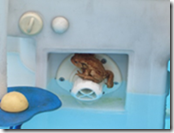 Du crapaud,
Du crapaud, 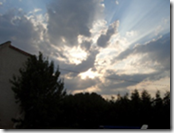 du coucher du soleil,
du coucher du soleil, 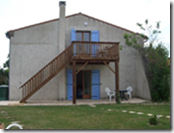 du gîte.
du gîte.
Part Two: Centre, July 2009
Saturday 4th July
With some sadness we left the gîte behind. We left Susie and Robin a replacement bottle of wine (it seemed wrong to leave the fridge plugged in but empty) and the promise of a testimonial e-mail on our return home. They promised us a cheque for our returned deposit on our doormat (which it was).
At 09.16 and 20.5°c we were waved off for the Loire Valley.
The journey north was surprisingly long, but also surprisingly easy. We headed along the Agout valley towards Toulouse, and then we simply followed the A20 from Toulouse all the way to Châteauroux. At the junction for Perpezac-le-Noir, midway between Cahors and Limoges, and roughly midway on our journey, it was 1.50pm and 28°c. Much of the landscape looked interesting, often open scrubby hillsides and occasionally wide or deep river valleys. Unfortunately we only saw what we could see from the motorway, and only fleetingly.
We came off the A20 at Châteauroux, and set Sally loose on the address of the gîte. Being in a town, this gîte did actually have an address that was recognisable to the satnav, unlike the previous one.
The roads were unsurprisingly good; they all seem to be of a high standard in France. They have lots of land, nearly twice as much as the UK, and the same number of people, and most of them live in cities. Therefore there isn’t the pressure to stick to winding lanes, their navigators can straighten out some of the bends or sweep along valleys or ridges.
We reached the town of Déscartes at just after 5.00pm. We had been told to find the housekeeper who lived over the road, and as we slowly approached the corner of the Rue de la Liberté that we knew (Google Earth is a wonderful thing) the gîte was on, there was a woman looking suspiciously at our UK-registration right-hand-drive car. She guessed we were us at about the same time as we guessed she was her.
Her name was Annick, and she spoke, apparently, zero English. What she was very clear about was the fact that she was commissioned to relieve us of a €100 deposit before handing over the keys. She let us in through the locked gates, showing us how to open and close them, and then where to park. When we entered the gîte our first impression was the smell of musty old cigarette smoke and dog hair. The place looked a bit tattered round the edges. Cathy wasn’t impressed. She was even less impressed a while later that evening when the people in the larger gîte showed us around and it was well kept and clearly looked-after, with decent quality furniture. Ours looked like an afterthought.
Stewart read the guest-book and noted that there was a long comment that had been tippex-ed out. Someone since then had scraped the fake paper off and you could read that a previous resident had not been happy about certain aspects of the condition of the property. It has to be said that the issues they had raised had been addressed, so heaven knows how unwelcoming it must have been if there were those problems on top of what we had found.
There was a comment from a woman who had stayed there for 6 months, and she and her dog had loved it. Shame the place still reeked of their presence. The sofa in particular was unattractively malodorous – as well as being well past its “use before” date. As the week went on, what made us laugh was that the “front” door had a gap under it that leaves would blow through every night. In winter it must be freezing.
We had brought our own bedding (thank God) and after sorting the place out as best we could we went into town, as much to get out of the gîte as to see where we were.
Déscartes is a small town or a large village, depending on your take on these things. We’d settle for a large village. There was a small town square with the usual suspects – bar, baker, cobbler, bank, newsagent, bar, restaurant, bank, estate agent, bar, bank, baker, restaurant… We ended up at an Italian restaurant, where we were warmly welcomed and served delicious food on their enclosed terrace. We left a €3 tip, and sauntered off towards the square again when the proprietor’s wife came running after us to thank us for the tip. They were nice people and the place had a relaxing atmosphere, so we resolved to go back again at the end of the week.
We walked off the meal by strolling down by the river Creuse, which although a pretty impressive river in its own right, is just a tributary of a tributary (the Vienne) of the Loire. Massive logs were still jammed against the bridge from the winter floods, and you could imagine the power of the water hurling them against the brickwork and the strains and stresses those piers must have been under.
Sunday 5th July
The advice from the gîte owners was to try the market in town on Sundays. We hadn’t managed to get to a “proper” French market yet, so this was the ideal opportunity. It was only about 300 yards up the road, past the Musée René Déscartes (his birthplace).
We were delighted. It was a long sprawling affair running from the bottom of the main square up to the top of another square that we hadn’t noticed the previous evening. Everything you could imagine as being “typical” of a French market was there. We focused on food, buying a big bunch of garlic and a huge pot of paella as well as bread and cheese and dried sausage.
We stopped for a coffee and to watch the world go by, then took the heavy food home (not far) before returning for a second browse. In the main square we found a cd and cassette tape stall, and at long last we found Cathy’s long sought-for collection of Tino Rossi songs on cd, which Stewart rather magnanimously bought her for her forthcoming birthday. In turn Cathy bought Stewart a pair of sandals on the principle that he had been wandering around in trainers and rolled-down socks all the time, and all the sensible people we had seen were barefoot in sandals.
After a light lunch, we really weren’t up for much sightseeing. We had a tv to watch in French, with French subtitles, which helped a bit. We got the Tour de France, and as the week went on saw it going through the places we had been to the previous week, including Andorra. There was also a pétanque tournament in Marseilles most of the week. But for this Sunday afternoon we were content to get some sun on us while we could (the weather forecast for the week wasn’t so clever, so catch it while you can seemed the best line to take). The garden was dominated by a cherry tree, which was shedding ripe cherries faster than the birds could eat them, resulting in a sticky sweet goo in the grass just where we all had to walk. The soles of our shoes were covered.
There were sun loungers, but they were not in the first flush of youth, and their mattresses (Homebase’s best) were falling apart too. But we managed to find a way, and with chilled wine loosened up with lemonade a pleasant sunny Sunday afternoon was had. In the evening we went to the bar in the square again, but this time for a beer instead of a coffee.
Monday 6th July
Somewhat belatedly by our standards, we went out in the car for a local orientation trip. Normally we would have done this on our first day in a new area. Over the Creuse bridge and we followed the river upstream through Leugny. On our right was a low cliff, and in the cliff face was a row of caves, many of them adorned with balconies or doorways, clearly a troglodyte development. These are quite a common feature in the area, the limestone worn away by the rivers exposing fissures that have expanded over the years into openings that can be enlarged and shaped almost at will.
We drove on to La Guerche, and then to Barrou where we followed the signs for Le Grand-Pressigny. It turned out that Château Le Grand-Pressigny is one of the more important châteaux in the area, housing a museum of prehistoric artefacts from the area. Sadly it was closed for major refurbishment until October, so we could only look at it from the main gate.
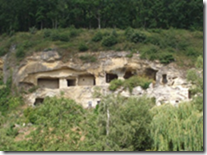 Troglodyte high rise;
Troglodyte high rise; 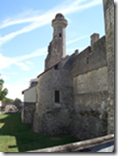 Chateau Le Grand-Pressigny;
Chateau Le Grand-Pressigny; 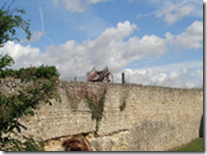 an agricultural scene
an agricultural scene
There were a couple of other châteaux in the area as well, although they weren’t on the list of “places to see”. We thought they looked pretty smart places, so it boded well for the more “A” list châteaux we planned to take in later in the week.
We had done some shopping, so tonight we had a barbecue, but sadly the Asda “instant party barbecue pack” we had brought with us wasn’t as instant as it said on the box, and the food took an age to get ready. But it got ready.
Eventually.
Tuesday 7th July
In our preparation for the holiday we had managed to borrow a book from one of Stewart’s colleagues; this was a guide to the châteaux of the Loire. One of them had caught our eye as having extra interest. It was the Château du Clos Lucé. This was of interest because Leonardo da Vinci, the famous code-maker, had spent the final three years of his life there. The King of France, François 1st, invited him there in 1516, and he turned up with whatever retinue he had plus three paintings rolled up in his saddlebags. A couple of the pictures were religious ones, St Anne and the (then) incomplete St John the Baptist, and the other was a small portrait of some woman known as La Gioconda. Not a bad little collection of souvenirs to take with you.
We got there very easily thanks to Sally (left at 10.56, 19.5°c), the Château being on the south side of Amboise. The first thing you do when you get there is to have a look around the château itself. It is not the biggest, not the most splendidly decorated, not the most imposing. In a way it is a cute little château. But it is very full of history. Leonardo completed a huge amount of work in the three years he was there, a lot of it designing town plans for François, as well as designing some of his many inventions. The château has a small museum of models of his more practical inventions. No photos allowed inside, so none to show. Outside however was a different story.
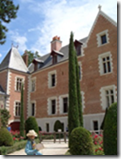 The rear of the Château from the Italianate garden;
The rear of the Château from the Italianate garden; 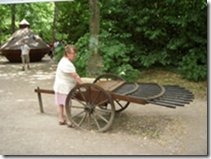 Cathy with Leonardo’s machine gun;
Cathy with Leonardo’s machine gun;
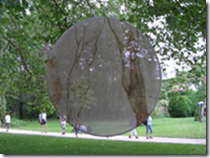 an enlarged detail of an anatomical drawing.
an enlarged detail of an anatomical drawing.
The grounds of the château were in effect a huge all-weather display of “Leonardo’s Greatest Hits”, whether it was machinery like his tank (visible behind Cathy in the photo above) or flying machines, or city layouts, or anatomical drawings, or his paintings… It really was an amazing experience, and one that passed a surprising amount of time. Altogether we spent five hours wandering around the château and its grounds. Don’t know where the time went.
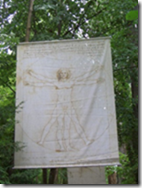 Vetruvian man;
Vetruvian man; 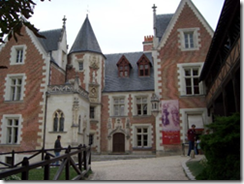 the front of the Château;
the front of the Château; 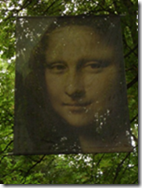 La Gioconda, enigmatic among the trees.
La Gioconda, enigmatic among the trees.
Wednesday 8th July
Having travelled a bit of a distance yesterday to Ambiose, we thought a nice short trip to have a look at a town, and maybe catch another market would be nice. A big town not too far away and on a fairly straight run from Descartes was Loches. To be honest, we had never heard of it, except as maybe a vague memory of it being part of something else in history. Anyway, we went there.
We should have heard of it. We probably had heard of it, just hadn’t remembered it. This was a serious place in the early part of the 1400s. Loches was a major citadel under Charles VII, whose court was relatively nearby at Chinon. It was here that he installed his “official mistress”, Agnès Sorel. The town is overlooked impressively by the massive fortification, which includes both a citadel and a Royal Lodge.
After going round the one-way system for a second time (damn, missed it!), we were able to park up very near the gatehouse, under the forbidding walls. The gatehouse was the only entrance/exit to the whole complex, and it was a narrow passageway that a transit van could only just squeeze through (we know this because we saw one do it). Once inside the narrow roads led directly to the church of Saint-Ours, with its bizarre twin octagonal cones built along the roofline.
From there we were able to turn left and look at 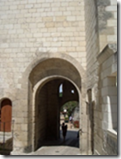 the Royal Lodge, or right
the Royal Lodge, or right 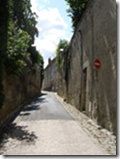 and head up
and head up 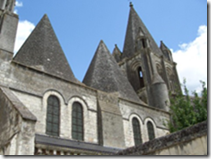 towards
towards 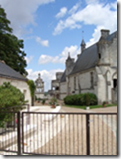 the citadel
the citadel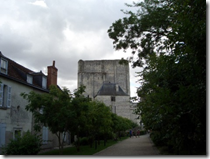 . Or just sit down and
. Or just sit down and 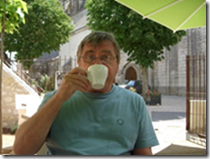 have a cup of coffee.
have a cup of coffee.
After looking around the church, and seeing the very elegant tomb of Agnès Sorel , we went to the main fortification. On the way to the Citadel we passed an interesting plaque on a wall, telling us that the former Canadian Prime Minister Jean Chretien had unveiled it in 2006 in memory of his ancestor Michel Chretien, who, born near to the church of St Ours, had at the age of 16, left his hometown of Loches heading for “New France” in 1656, a mere 350 years before. We assume he got there OK.
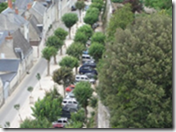 our blue car (centre of picture);
our blue car (centre of picture);
We spent an age climbing unlikely winding staircases or negotiating rickety flooring, and looking at ancient weapons of personal destruction and traces of the people who had been holding those weapons. Among the traces were some fascinating wall carvings of life-size figures of soldiers. We took lots of photos of them, but the carved relief is not outstanding enough to make a significant impression on our limited camera. Originally this wouldn’t have been a problem as they showed traces of having been coloured in.
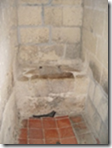
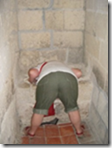
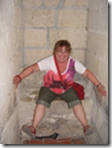 Cathy finds the castle toilet.
Cathy finds the castle toilet.
Stewart is kept prisoner in the “cage”.
Then we went to the other end of the site again, to look around the Royal Lodge. It was here that Charles VII was confronted by Joan of Arc (Jeanne d’Arc) in 1429 and told to grasp the nettle of kingship and go beat up those pesky English. Maybe not quite in those words, but you get the message. Jeanne d’Arc is unusually revered in France; every church or cathedral we visited had a statue and side chapel in her name. There was very definitely a sense of history standing in the same room as she and the king had occupied nearly 600 years ago.
The Lodge had a room dedicated to Agnès, and the similarity between portraits of her and of religious paintings of the Virgin Mary with her posing in the main role were pointed out in great detail. Clearly Agnès was more important to the people of France than many legitimate royals. And equally clearly the Virgin Mary was blessed with a magnificent bosom? Don’t times change?
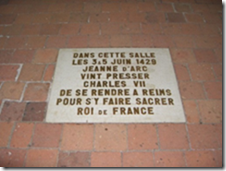 Jeanne d’Arc’s plaque;
Jeanne d’Arc’s plaque; 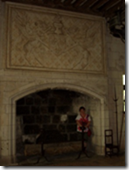 our new fireplace;
our new fireplace; 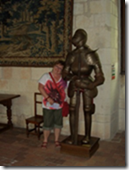 Cathy’s new friend.
Cathy’s new friend.
The Château at Loches was a pleasant surprise; we hadn’t intended to explore it, but we had enjoyed it immensely. It had taken all day as well, and we had missed any chance of shopping (not that our aching plates were in any fit state by now). Never mind, it had been worth it. After another cuppa, we wandered back down through the gatehouse and returned to the car. We were determined to check out Agnès on Google when we got back to our computer at home in England.
Thursday 9th July
Lazy day today, didn’t do a lot most of the day except watch the Tour de France on the tv and vegetate. That was because we had a cunning plan for the evening. We had been to the tourist office earlier in the week and had spotted a Songes et Lumières performance based on the Greek myth of Psyche and Cupid. It was at the Château d’Azay-le-Rideau, which was built on a lake created out of a slow section of the River Indre. The Château is literally built into the lake, with two sides rising up out of the water, and the other sides opening onto parkland and an impressive driveway.
We arrived at the town of Azay-le-Rideau in mid-afternoon, after passing through more sunflower fields. We had to stop and have our Vinny Van Gogh moment:
We reached the town just as the cafes were closing, as usual. However one of them was still serving snacks, so we had a Croque Monsieur each with our coffees. We hadn’t had one of those for a while. It is basically a double-decker toasted sandwich, with ham in the lower deck and cheese in the upper deck. The town itself was very pleasant, and we wandered about looking at the shops. Most memorable was an art shop, which housed a busy collection of really very nice paintings and carvings. It wasn’t so much that we couldn’t afford one (or more), it was just that we couldn’t think of a wall to put one on. At the end of the main street of olde worlde shoppes was a huge circular square (no, that can’t be right… a huge circular circle, then), which had the Château’s gateway, side entrance to the stables (now a modern toilet block), and the tree-lined drive focused into its centre.
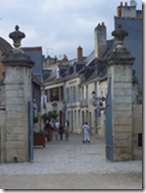 Street of shops leading to the Château;
Street of shops leading to the Château;
Of course with the Château being such a major tourist attraction there was plenty of tourist rubbish to be purchased. Most of the shops were selling identical items, but at different prices – so if you judiciously went from shop to shop you could save a fortune buying specific bits and particular bobs from individual shops. We bought nothing.
We had brought a picnic with us for the evening, as the light show didn’t start until it got dark (really?), and we had a few hours to kill. We had managed to park close to the Château, so we went back to the car and sat there and tried to have a bit of a snooze. There were people in motor homes and others in cars doing the same thing. We thought that some of the motor homes might be settled in for the night, being parked up on those wedges that they use to get the floors level.
So after a fitful doze (imagine waking up at 12.30am and having missed it all?) and a pick at the picnic, we got to nearly 10.00pm, and dusk was falling. Time to go to the Château and check out the Songes et Lumières.
There was a reasonable crowd there, maybe a couple of hundred or more people altogether. The first glows of the lights were beginning to be visible, and we began to follow the directions, trying to take sensible photos wherever we could. It was difficult because we couldn’t turn off the flash on the camera, so the “right” shot wasn’t available as often as we would have liked.
We started down the driveway towards the front facia, following a line of red “runway markers”. Once we got to the main entrance of the Chateau, we were guided into the stairway – this was strange as it was open to the elements at the front, like a series of porches placed one upon the other. The vaulted roof of each landing was differently decorated, and illustrated the total opulence of the commissioner’s design.
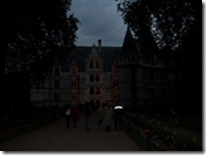 the façade begins to light up;
the façade begins to light up;
We were encouraged to follow a pathway of little uplights set into the ground, each with a picture of trees engraved into it, that you could only really see from directly overhead. The bridge took us across the river Indre, which was doubling for the Styx as we entered the world of myth, and was decorated with a forest of long tubular lights strung above it. We then followed the path towards some strange red shapes glowing in a clearing among the tress. There were eerie voices and music playing as these shapes gradually dimmed and relit – apparently they were meant to be fiery salamander footprints, the symbol of François I, the king when the Château was built.
We went on round, and were treated to the sight of the whole wall of the castle above the lake being used as a projection screen. That was spectacular, but then we wandered into the strange world of the dead. In the trees were white lighting tubes curved and formed to look like ribcages, and as we went further into the trees there was a fantastic effect of prisms through spotlights lighting up the leaves on the trees. This gave a sense of danger combined with a feeling of calm and sheer impressive power.
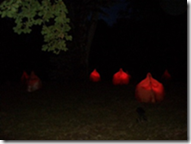 Fiery salamander footprints;
Fiery salamander footprints; 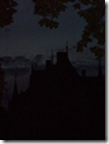 the Château silhouette;
the Château silhouette; 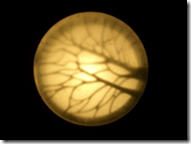 the pattern in the trail lights.
the pattern in the trail lights.
Supposedly the effect on the leaves was meant to represent ermine, silver tips to dark furs. The ribcages are supposed to be cocoons for nymphs to shelter in. Just shows how insightful and artistically aware we are then…. On we went to the misty bridge over the river, where we had great fun taking photos and pretending to be ghosts.
Then we got halted in our steps as we watched the light show on the western wall of the Château. Once again the walls grew vertically out of the lake, and this light show projected onto it was a spectacular musically accompanied display that we just stood mesmerised by. It was truly fantastic. Rich deep blues and greens represented the “drowned garden brought back to life”. Mesmerising indeed.
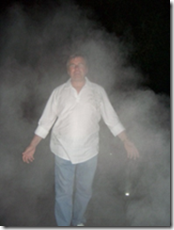 Stewart emerges from the mist;
Stewart emerges from the mist; 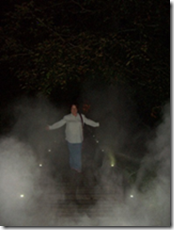 so does Cathy;
so does Cathy; 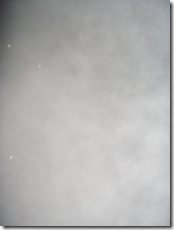 so does the ghost!
so does the ghost!
That brought us to the end of the show, but we simply went round again. This time the façade of the Château was more clearly lit as it was fully night by now, and the images projected onto that were recreations of what the tremendously rich tapestries, so often hung in the Châteaux, might have looked like in their vivid newness.
By the time we had finished the second circuit, it was midnight, and closing time. We had a long-ish drive back to Déscartes, but the roads were almost completely empty and Sally was on form. As we drove through the countryside were became aware of the wildlife, especially as we saw a deer bounding along on the other side of the road and disappearing into a sunflower field. Not surprisingly we also saw a couple of foxes.
Friday 10th July
We had a lazy day in Déscartes today. In the early afternoon we went up the road to look around René’s museum. It was the only museum or tourist attraction we had visited in France in the two weeks that had no translations. Everything was in French. The pictures were OK, and being an educational resource for the locals as well as a museum there was some fairly juvenile information that we could absorb quite well. However René Déscartes is possibly best known as the philosopher immortalised by Monty Python in the “Philosopher’s Song” by the line “and René Déscartes was a drunken fart: I drink, therefore I am!”
But seriously, philosophy is a tough enough call in English, and we were being presented with the development of his thought processes in French. Cathy quickly gave up, and Stewart slowly ploughed as best he could for a while, before giving up the will to learn and finding the Monty Python rhyme repeating in his head in spite of his best intentions. I think, therefore I am (getting out of here).
Tomorrow would bring us two significant events. Firstly, it was Cathy’s birthday, and secondly, it was the day we finally got out of our second favourite gîte of the fortnight. So we packed up and gave the place a cursory cleaning. We just wanted to make sure the place was up together enough to get our deposit back and then get the hell out of there. Earlier in the week Stewart had broken one of the wine glasses, so we had bought a pack of three to replace it with – we took the other two home; they weren’t staying!
That night we went back to the Italian Restaurant for Cathy’s birthday meal. Once again the food was delicious, and this time we knew a bit more about how their menu worked. We had a very nice three-course meal with wine and coffee for €45. It was thoroughly enjoyable and not a hint of indigestion. Afterwards, we went to the local patisserie and bought a couple of lemon tarts as Cathy’s birthday cakes.
Saturday 11th July
We had to be out of the gîte by 10.00, but we had no intention of hanging around. Cathy opened her French birthday card (Bon Anniversaire) and her surprise Tino Rossi cd. The car was packed by 8.45, and we had a light breakfast of mainly coffee. Cathy had most of one of the lemon tarts that had been sitting in their bag on the table overnight; Stewart had a mouthful of it, not being hungry enough to have the whole one that was reserved for him. We wrapped that one up and put it with our food to eat on the road.
Stewart wrote a comment in the visitors’ book:
“Well, we have had an exhausting week of chateaux & trogs & wines & museums. A great part of the world to explore.
“But…. We would echo concerns about the gîte that the Matthews’ (previous occupants) made – it needs a good dose of TLC. It is one thing to be “rustic”, but “rustic” does not need to be dirty nor does it mean lack of care. This could be a great little cottage if it was really taken care of. This also applies to the garden, which needs more than just the occasional strim – after all the “Bananiers” label is focused on the delights of the garden.”
Annick came over and gave the place the briefest of once-over checks, then handed over Cathy’s €100, we handed over the keys, told her it had been OK (cowards) and we waved farewell.
We headed north with Tino giving it some serious vocals, and Sally started to show some interesting details on the traffic alerts – none that actively involved our planned route, but it was clear there was a lot of traffic on the roads. Of course there was, this was the Saturday immediately before 14th July, the busiest weekend of the year on the French roads. Fortunately most of it was heading south for the sun, and we were heading north for (as it turned out) the rain. (Memo to self – never drive to the south of France the weekend before Bastille Day)
We saw plenty of traffic jams. Our route took us onto the bypasses at Tours and Le Mans. At Le Mans we were held up very slightly where the traffic from Paris and the northeast joined us for a few miles, but otherwise we were fine. We saw one jam that went from about 5 miles south of Tours to about 6 miles north of it, 11 miles of virtually stationary traffic headed in the opposite direction to us. We thus made good time, but it was more through luck than judgement that we had chosen the holiday dates we had. That jam could easily have included us.
Cathy took over the driving, but wasn’t feeling up to it after less than an hour, so Stewart took over again. By the time we passed Caen and neared Bayeux she had been asleep for a while. We were headed for a shopping centre we were familiar with near Cherbourg, and although we had been on the road without stopping for a long time, we ploughed on until we reached La Glacerie Retail Park.
After doing a bit of browsing, we sat down for a bite to eat and a cup of coffee. Cathy wasn’t feeling too bright for a birthday girl, but she had a burger and chips. Stewart had a salad. After a little more browsing, we went back to sit in the car. We were really retailed-out, not needing to buy anything, not even more wine. And Cathy wasn’t feeling any better, only more and more uncomfortable.
We sat in the car in the car park, and the first spots of drizzle landed on the windscreen. Soon Cathy was complaining of feeling sick, and she got out of the car and went over to a bushy patch of grass and promptly relieved herself of her burger and chips. And more. Out with the wet-wipes.
This feeling of being sick wouldn’t go away, and she was in and out of the car reaching several more times. By now the drizzle had turned to rain, and it had set in for the rest of our holiday. Cathy was in need of a coat draping over her shoulders as she retched next to the car. We had a vision of the locals spotting her and tut-tutting about crazy Anglais who come over here and binge-drink themselves sick by the afternoon. If only.
Along with the sticky used wet-wipes Stewart took the remaining lemon tart to the nearest rubbish bin. Leaving them out all night had clearly not been a good thing to do. At least Cathy could just about raise a smile at the thought that she had spent her birthday just like a teenager – being sick. All we could do was to hope that she had vomited whatever was causing her upset out of her system; we still had a ferry to catch. There was no doubt that she had a dose of food poisoning, and we remain convinced the lemon tart was to blame.
It took her over a week to recover properly, but in the meantime we just kept her hydrated and comforted on the ferry and into the car and home. It was a shame the holiday ended so miserably for Cathy, as up to that point we had had a really great time.
We arrived home off the fastcat at just after 11.00pm UK time. It was lashing down with rain.
We had done a grand total of 2286.4 miles since setting off a fortnight before.
Well done car; well done Sally; well done us.
Fin
